The impact of lower UK milk supply has so far had a limited impact on Cheddar retail prices. But not for much longer…
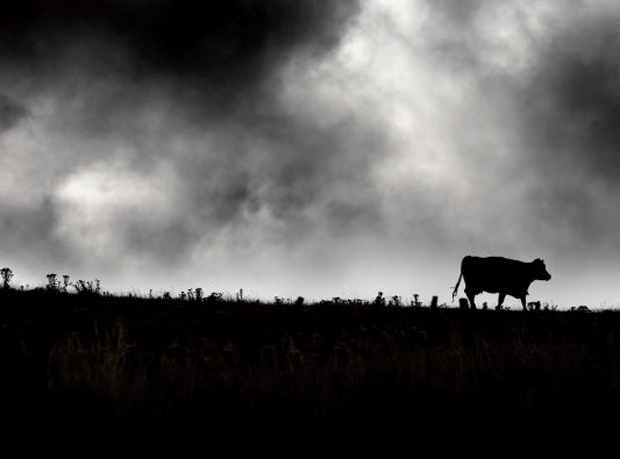
If there’s one thing us Brits are famous for, it’s talking about the weather. But even by British standards, the cheese industry’s current obsession with all things meteorological is unusual.
There’s good reason for the incessant weather talk, though: over the past 12 months, British dairy farmers, Cheddar suppliers and supermarket cheese buyers have had to contend with a perfect storm of bad weather conditions.
Last year’s downpours ruined forage crops - forcing farmers to buy in additional feed and driving up input costs - and this year’s cold spring reduced milk output, leaving cheesemakers scrambling for British milk as processors prioritised liquid milk production in order to fulfil business-critical milk contracts with the major mults.
As a result, the UK produced 19,419 tonnes less cheese in the year to June 2013 than during the previous 12-month period - a drop of 4.9% [DairyCo]. The picture for Cheddar is even worse: according to provisional figures from Defra, UK Cheddar production in the first quarter of 2013 was down 17.6% year on year to 56,000 tonnes.
At the same time, consumer demand for Cheddar has continued to grow: Brits have eaten an additional 2,607 tonnes of Cheddar over the past year, as total category volume sales have risen by 1.2% to 229,125 tonnes, and value sales rose 1.8% to £1.5 billion [Kantar Worldpanel 52 w/e 9 June].
“Mature Cheddar won’t escape as price rises in mild trigger rises across all cheese types” David Young, First Milk
High demand coupled with tight supply can mean only one thing: prices must go up. Wholesale prices for mild and mature Cheddar stood at £3,325/tonne and £3,525/tonne in July - up by 16.7% and 10.2%, respectively, year on year, and retail prices are likely to follow.
But which parts of the category will be hit hardest? And what impact will higher prices have on promotions?
To date, the impact on retail Cheddar prices has been limited. According to BrandView.com, the average price of mature Cheddar skus in the top five supermarkets has gone up by 3% from £3.25 to £3.34 over the past year.
“As the decreased availability of cheese stocks starts to filter through to the marketplace, this is likely to change,” warns David Young, marketing director at First Milk.
Read this
Cheddar 2013: What’s in store?
Total Cheddar sales have grown over the past 12 months. But scratch the surface, and all is not quite what it seems. Read more on this web exclusive for The Dairymen.
Wyke Farms goes further. It’s not a case of ‘likely’, says MD Rich Clothier - price rises are inevitable. He points out milk is currently fetching over 40 pence per litre on the spot market, and if that doesn’t come down soon, cheesemakers will need to pay farmers on cheese contracts higher prices for milk.
“Retail Cheddar prices must rise; manufacturers will have to secure increases,” he says.
If weather conditions are challenging again this year and feed remains short, the Cheddar industry could be in a “dire position”, given dairy stocks are already low, Clothier adds.
This sounds like scaremongering, but other experts agree with Clothier’s analysis. In its Cheddar supply chain margins report, published last month, DairyCo warns “with UK farmgate prices continuing to rise in the first half of 2013/14, processors could see Cheddar margins eroded to a point where scaling back production and/or diverting milk into other markets is either financially sensible or a financial necessity”.
Once retail prices start going up, mild Cheddar is likely to be the first Cheddar sub-category to be hit: with its short production cycle - it’s typically sold at around three months of age - it is more immediately sensitive to price movements at retail.
But more mature variants are not going to escape unscathed. An increase in the price of mild “usually triggers the need for price increases across all cheese types in order to secure supply,” says Young.
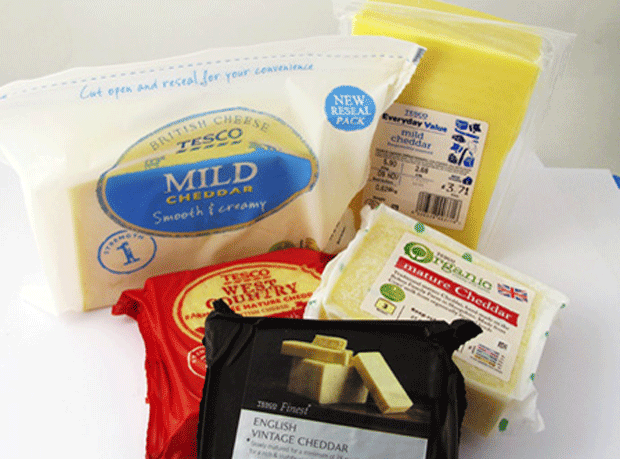
Promotions crunch
Rising retail prices won’t be the only fallout from the recent bad weather: suppliers, retailers and - ultimately - consumers face a double whammy because higher wholesale prices and reduced availability of Cheddar also mean there is likely to be less cheese available for promotions.
The news couldn’t come at a worse time, with retailers ever more reliant on volume deals to sell Cheddar and promotional levels running at their highest for at least two years. Kantar data shows a staggering 50.5% of total Cheddar volumes were sold on promotion in the last 12 months compared with 46.3% for the same period in 2012 and 48.5% in 2011.
Less Cheddar available for promotions is bad news for cheese suppliers, who tend to be keen on promotions to increase consumption. “Cheese is an expandable category, meaning that usage does increase in-line with volume sold,” says Adam Mehegan, shopper marketing controller at
Cathedral City and Davidstow owner Dairy Crest. “Cathedral City will always aim for the right marketing mix to maintain its position as the number one cheese brand in the UK. In the current climate this does include an intelligent promotional programme.”
Tipping point
However, other suppliers - such as Arla - believe the Cheddar market has reached its promotions tipping point in any event, so reduced availability will provide a good impetus for suppliers and retailers to take a deep breath and think of a new strategic direction. Consumers have become increasingly savvy to promotions and are increasingly less likely to be swayed by price or volume-led deals, believes senior brand manager Kate
Richards, who looks after Arla’s Tickler and newly launched Anchor Cheddar brands. “Instead, more consumers are looking for added value fromthe products they buy through gift-with-purchase or on-pack promotions.”
“Retail Cheddar prices must rise; manufacturers will have to secure increases” Rich Clothier, Wyke Farms
Arla’s not alone in predicting a longer-term shift in promotional levels. Fayrefield Foods says it has dialled back its support for volume deals and channelled more investment into TV, press, in-store tasting and couponing support for its Collier’s Cheddar brand. “In the short term, it has impacted sales slightly, with less sold on deal, but long term the aim is to drive growth with a mix of above and below-the-line support,” says sales director Dan Harper.
Young at First Milk also believes promotional levels are at saturation point. Even if cheesemakers and retailers wanted to ramp promotions up further, they might not be able to do so, he warns. “The availability of cheese stocks will undoubtedly have an impact on the supplier’s ability to secure increased promotional stocks.”
No more cheap Irish Cheddar
Lack of availability and rising prices aren’t just UK problems either. Previously, if something in the UK - such as poor weather - hit cheese production, retailers were able to look to Ireland for cheaper Cheddar to fuel promotions. It’s something they have been heavily criticised for in the past by the likes of the National Farmers’ Union, but there’s little chance at the moment of cheap Irish Cheddar bailing out deal-hungry mults.
“There’s no cheap Irish Cheddar,” is the stark warning from Alastair Jackson, sales and marketing director at Irish Dairy Board-owned Adams Foods, which owns the Pilgrims Choice and Mu Cheddar brands.
He points out milk prices in the Republic of Ireland have risen more than in the UK, up by 9 cents per litre (cpl) from about 28 cpl a year ago to roughly 37cpl in August. By contrast, UK milk prices have risen by about 5p per litre (the equivalent of about 6pcl) during the same period. The most recent figures for average milk prices across the EU show farmgate milk prices in Ireland stood at €36.22/kg in May, whereas UK prices stood at €34.15/kg [DairyCo].
“The UK cheesemakers are as competitive, if not more competitive than us,” says Jackson.
With milk prices - UK and Irish - tipped to head still further north, retailers and suppliers are going to have to work harder to add value to their categories.
“Building trust with consumers over origin and quality is key in developing loyal customers” Lidl spokeswoman
This will be a particular challenge for brands, which have had a rough time competing against own label over the past 12 months. Branded value sales have fallen by 2% to 99,662 tonnes over the past year, while own label has grown by 3.7%, to 129,463 tonnes [Kantar]. Own label is also outpacing brands on the value side, gaining 2.9% year on year to £786.5m, against branded’s meagre 0.5% growth, to £685.2m.
First Milk’s Young says the figures reflect the fact that all of the major retailers have recently relaunched their standard own-label Cheddars, bringing in new pack sizes, additional promotional activity and new pack designs, and they’ve also remerchandised their categories.
Whether brands can fight back will depend on marketing and promotional activity over the next 12 months, he says, but there are no signs so far that own label’s charge is slowing. “At the moment, the percentage growth of own brands look set to be at a higher level than brands and over the past 3 months, the gap has been widening.”
Wyke Farms’ on the other hand, believes the retailers’ strong performance is down to them shrinking their margins on own label to allow them to steal share from the discounters, whilst keeping the margins on brands higher. “This really is a watershed as it shows that retailers will reduce margins in order to compete,” he says.
As brands seek to fight back and retailers look to keep their own-label growth rates on the boil, going big on British sourcing is emerging as a popular strategy, especially in light of the horsemeat scandal earlier this year. But backing British comes with risks attached - if the weather continues to be extreme and British milk production falls further, a retailer with a British-only pledge on Cheddar could get caught out.
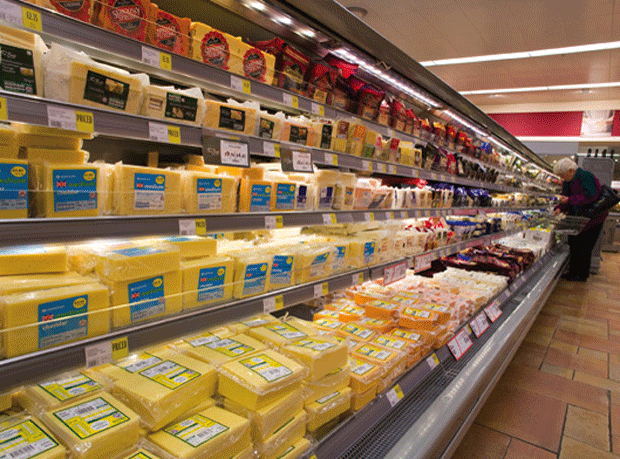
New deals
That’s why the major supermarket chains are increasingly taking an interest in setting up new partnerships with processors and producers to safeguard their cheese supply chains and ensure they have a sustainable supply of Cheddar.
At the beginning of July, Morrisons launched a new pricing model for farmers who supply milk - through First Milk - into Morrisons’ own-label Cheddar, featuring a new farmgate pricing model that takes into account the prices of key commodities including skimmed milk powder, cheese and whey powder. The model applies only to mild Cheddar - a relatively low volume line - at the moment, but Morrisons intends to extend it to further Cheddar lines in the future.
In a similar vein, Tesco is hotly rumoured to be readying a dedicated supply group for British cheese in the vein of its successful dedicated liquid milk group in partnership with its own-label cheese supplier Adams Foods and the British cheesemakers it works with.
“The UK’s cheesemakers are now as competitive as the Irish” Alastair Jackson, Adams Foods
Meanwhile, Dairy Crest - which launched a groundbreaking formula contract for its fresh liquid milk suppliers earlier this year - is already considering to what extent that formula could translate to those farmers who supply it with milk for Cheddar making, although CEO Mark Allen says the jury is still out. “I’m not sure sitting here today that it is relevant for cheese because our cheese contract is bespoke for cheese in terms of its constituents,” he tells The Grocer.
On a less ambitious scale, Lidl added three additional British block Cheddar lines to its cheese offering this summer to boost its provenance credentials. “We feel that building trust with the consumer over origin and quality expectations will be key in developing more loyal, happy customers,” says a spokeswoman.
Such initiatives - big or small - demonstrate the growing importance of securing supply chains to retailers and suppliers. And they are right to take security of supply seriously: “Cheddar production could continue to be constrained as competition for raw milk supplies remains throughout 2013,” DairyCo says ominously.
Whilst this year’s weather has provided much-needed respite for last year’s rain-drenched farmers, and shoppers have been out celebrating the hot summer, for Cheddar prices at least, it’s an ill wind that blows. The forecast? Gloomy.
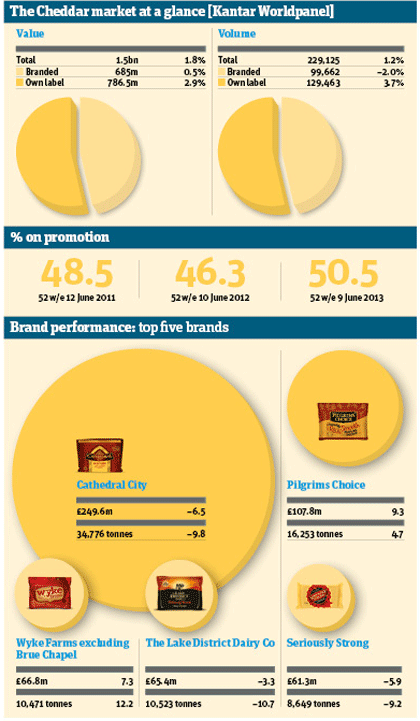







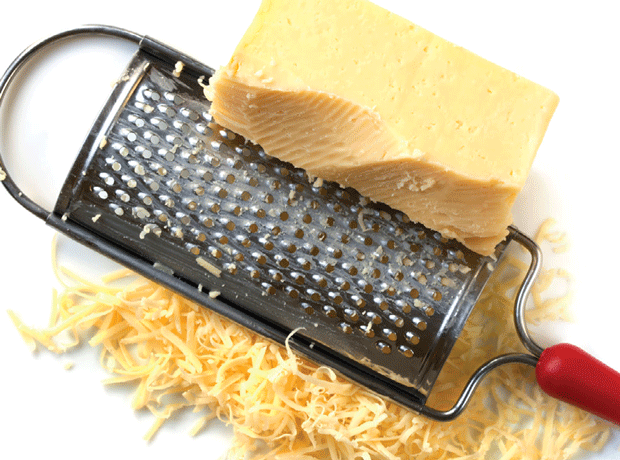

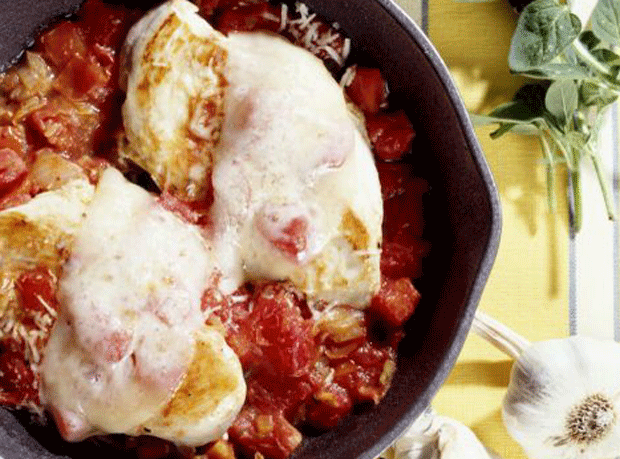










No comments yet